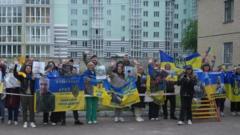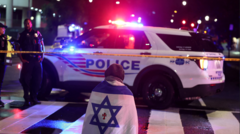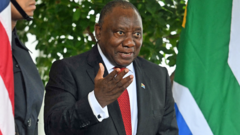**In the wake of President Trump's controversial video alleging genocide against white farmers in South Africa, local residents clarify the context around a temporary memorial for murder victims, debunking claims of a burial site.**
**Misrepresentation of a Memorial: Understanding Trump's Claims on South African Farmer Deaths**

**Misrepresentation of a Memorial: Understanding Trump's Claims on South African Farmer Deaths**
**A deeper look at the South African memorial cited by Trump, misconceptions arise over its true nature.**
The P39-1, a quiet road in KwaZulu-Natal, South Africa, became a focal point of international controversy after President Donald Trump used images of a temporary memorial in a video aimed at South African President Cyril Ramaphosa. This video, released Wednesday, suggests that white farmers in South Africa are facing genocide, a claim many local residents vehemently dispute.
The memorial, consisting of white crosses originally erected in remembrance of notable farm murders, has often been misconstrued. Among these victims were Glen and Vida Rafferty, whose brutal killing in 2020 sparked outrage and led the Afrikaner community to temporarily plant crosses along this highway in their memory and in solidarity with other victims of farm violence.
During a visit to the P39-1, it became evident that the crosses have since been removed, leaving little trace of the once-emotive display. Local farmer Roland Collyer, who lost relatives to farm violence, explained that the crosses symbolized the lived experiences of farmers facing violence and theft at home, driven by the region's complex socio-political landscape.
Rob Hoatson, a neighbor of the Raffertys, clarified that the memorial was not intended as a graveyard but rather a temporary tribute to raise awareness of ongoing violence against farmers, a significant issue across the nation. While Trump’s framing amplifies concerns about race relations, it fails to reflect the community’s true narrative — that this area is not characterized by the tribal conflict he alluded to.
As crime rates in South Africa rise, including high murder statistics impacting all demographics, community members express their sorrow not just for the Raffertys but for the repercussions felt across all races. They recount a history of fears in the aftermath of personal tragedies like these, yet many refuse to succumb to division.
Collyer articulated a desire to remain in South Africa, even amidst widespread fears about security, stating the difficulty of abandoning ancestral ties built over generations. He emphasized a vision for unity moving forward, aspiring to bridge relationships between different communities.
Among other locals, like Bethuel Mabaso, there’s disbelief that their peaceful neighborhood has gained such dubious international notoriety. The overwhelming sentiment is one of longing for calm in a country still healing from its deeply segregated past, with calls for understanding and collaboration among all racial groups in order to cultivate a more harmonious society.
As the international media spotlight shines on the ideals presented by President Trump, individuals living in these communities underline a shared humanity that transcends the divisive narratives often emphasized in political rhetoric.





















